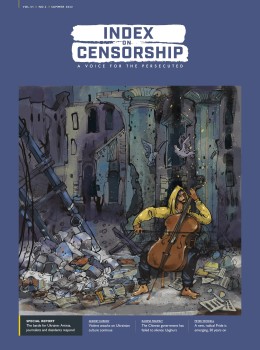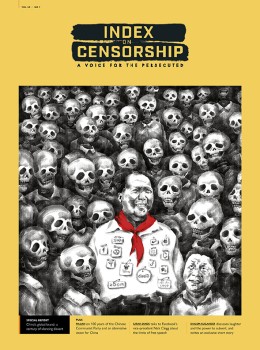[vc_row][vc_column][vc_custom_heading text=”As the Summer 2017 issue of Index on Censorship magazine looks at the modern implications of the Russian revolution 100 years on, Margaret Flynn Sapia lists 10 global songs inspired by revolutions of the last century”][vc_row_inner][vc_column_inner][vc_video link=”https://www.youtube.com/watch?v=Q2wneBVssPc&list=PLCY0ZVWasL3FginL7uuYQJy6JfXGIWmGu”][/vc_column_inner][/vc_row_inner][/vc_column][/vc_row][vc_row][vc_column][vc_column_text]
Music has an undeniable ability to move people; musicians can reach across borders and boundaries, pull at the heartstrings and say the unsayable. As a result, music has long been used to call for revolution, urging listeners to rise up against injustice and power. For the launch of Index on Censorship magazine’s summer 2017 issue, 100 Years On: What difference Russia’s revolution makes to our freedom today, we have compiled a playlist themed around the idea of revolution.
Tracy Chapman – Talkin ‘Bout A Revolution
In a world gripped by the denouement of the Cold War, Tracy Chapman saw change on the horizon. “Poor people gonna rise up /And get their share/ Poor people gonna rise up/And take what’s theirs” sums up the sentiment of Talkin ‘Bout A Revolution. Optimistic, perhaps, but the song arrived in 1988, at the cusp of a global uprising that saw the fall of Apartheid South Africa, the Soviet Union and several smaller communist regimes, as well as a Western ideological shift away from the ruthless capitalism of Thatcher and Reagan.
Gil Scott-Heron – The Revolution Will Not Be Televised
The Revolution Will Not Be Televised was released in 1970, at the end of a turbulent decade that saw the assassinations of several civil rights heroes including John F. Kennedy, Martin Luther King, Malcolm X and Fred Hampton. It calls on people to unite and take action beyond watching a television screen, warning that the revolution will not come with the glitz and glamour of television, and that the television will not be on their side. Gil Scott-Heron, an important figure and musician during the US Civil Rights movement, is keen to call for realistic understandings of how change can be achieved in this song.
The Specials – Nelson Mandela
The Specials’ Nelson Mandela drew popular attention to Mandela’s mistreatment in South Africa when it was released in 1984, bringing the injustice of his then two-decade imprisonment into common knowledge. When it was performed at a Wembley concert on Mandela’s 70th birthday in 1988, its chorus of “free Nelson Mandela” became a global rallying cry for the end of apartheid. Two years later, Mandela walked out of prison, and the apartheid regime fell shortly after.
David Zé – Mwangolé (O guerrilheiro)
One of Angola’s most renowned revolutionary artists, David Zé is particularly adept in his descriptions of the suffering and abuse of Angolans under Portuguese colonial rule. Mwangolé O guerrilheiro may not call for a specific course of revolutionary action, but its representation of the enduring pain and intolerable living conditions of Angolans remind listeners of what can drive a person to risk everything and revolt for their freedom. In a country that suffered through a generation-long civil war, that context can never be forgotten.
Carlos Puebla –Y en eso llego Fidel
“The fun was over, El Comandante came and ordered them to stop”, Puebla sings in this famous hymn to the Cuban revolution. Throughout the song, Carlos Puebla celebrates Castro’s arrival and overtake of the island, putting an end to capitalism’s prior corruption and exploitation of the island’s people. The droves of people who fled the subsequent corruption and exploitation by Castro’s communist regime might dispute the song’s celebratory tone.
The Korean People’s Army State Merited Chorus – Defend the Headquarters of the Revolution (혁명의 수뇌부 결사옹위하리라)
In North Korea, even revolutionary music – what should be defined and expressed by the people, free of censorship – is an unyielding expression and promotion of state power. Defend the Headquarters of the Revolution provides no mention of Korean culture or history preceding Kim Jong II, instead extolling the virtue of picking up arms for the Kims and fighting to the death, viewing this fight as a revolution against the rest of the world.
Vasily Agapkin – Farewell of Slavianka
Farewell of Slavianka (Proshchaniye slavyanki) became so popular during the 1917 Revolution that, despite its non-communist roots, the Soviet Union eventually adopted it as an official national song. This piece represents two fundamental components of revolution: popular sentiment during the people’s initial rebellion, and post-revolutionary appropriation of that sentiment into state propaganda.
Yulduz Usmonova – Ayting Ayting
Songs which explicitly detail Soviet occupation in Uzbekistan are scarce. However, songs sung in Uzbek instead of Russian (especially before the country’s independence) have long served as expressions of nationalism and rejection of the Russian hierarchy. Ayting Ayting is not a typical revolutionary song, but its defiance lies in its subtle refusal to conform to Russian norms.
Yoko Ono and John Lennon – Imagine
“Imagine there’s no countries, it isn’t hard to do, nothing to kill or die for”, sings John Lennon. This song co-written by Lennon and his wife Yoko Ono asks us to contemplate a different kind of revolution – not a singular uprising or struggle, but a new peaceful world where the divisions of religion and nationality have disappeared. The chorus of “You may say I’m a dreamer, but I’m not the only one” hints at the faint possibility of this future, if people could only come together long enough to realise how similar they are. In a sad irony, he was eventually assassinated by a mentally ill Christian extremist who considered this blasphemy.
Crosby, Stills, Nash and Young – Ohio
The Vietnam War and its national impact are deeply entrenched within US society, and have inspired countless pieces of art, film and music. Crosby, Stills, Nash and Young’s song Ohio was written in response to the 1970 Kent State University massacre, in which national guard soldiers opened fire on anti-war student protesters leaving four dead and nine wounded. The song was released just a few weeks after the incident, and placed the blame directly on the Richard Nixon administration. It was soon adopted as an anthem of the US’s anti-establishment movement.
[/vc_column_text][/vc_column][/vc_row][vc_row][vc_column][vc_column_text]
Print copies of Index on Censorship magazine are available on Amazon, or you can find information about print or digital subscriptions here. Copies are also available at the BFI, the Serpentine Gallery, MagCulture, (London), News from Nowhere (Liverpool), and Home (Manchester). Each magazine sale helps Index on Censorship continue its fight for free expression worldwide
[/vc_column_text][/vc_column][/vc_row][vc_row content_placement=”top”][vc_column width=”1/3″][vc_custom_heading text=”100 Years On” font_container=”tag:p|font_size:24|text_align:left” link=”url:https%3A%2F%2Fwww.indexoncensorship.org%2F2017%2F06%2F100-years-on%2F|||”][vc_column_text]Through a range of in-depth reporting, interviews and illustrations, the summer 2017 issue of Index on Censorship magazine explores how the consequences of the 1917 Russian Revolution still affect freedoms today, in Russia and around the world.
With: Andrei Arkhangelsky, BG Muhn, Nina Khrushcheva[/vc_column_text][/vc_column][vc_column width=”1/3″][vc_single_image image=”91220″ img_size=”medium” alignment=”center” onclick=”custom_link” link=”https://www.indexoncensorship.org/magazine”][/vc_column][vc_column width=”1/3″ css=”.vc_custom_1481888488328{padding-bottom: 50px !important;}”][vc_custom_heading text=”Subscribe” font_container=”tag:p|font_size:24|text_align:left” link=”url:https%3A%2F%2Fwww.indexoncensorship.org%2Fsubscribe%2F|||”][vc_column_text]In print, online. In your mailbox, on your iPad.
Subscription options from £18 or just £1.49 in the App Store for a digital issue.
Every subscriber helps support Index on Censorship’s projects around the world.
![]() SUBSCRIBE NOW[/vc_column_text][/vc_column][/vc_row]
SUBSCRIBE NOW[/vc_column_text][/vc_column][/vc_row]












